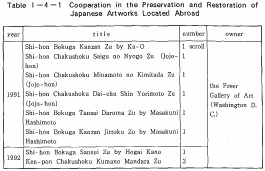| Home > Policy > White Paper, Notice, Announcement > White Paper > JAPANESE GOVERNMENT POLICIES IN EDUCATION, SCIENCE AND CULTURE 1993 > CHAPTER 4 �3 1 | ||
Because Japanese artwork housed in museums and other institutions in Europe, America and other countries do not undergo periodic maintenance due to a lack of local technical experts in the area of preservation and repair, the passage of time has left many of these items in an inferior state of preservation. It is necessary that these Japanese artworks be preserved and utilized properly, as they contribute to an understanding of Japanese traditional culture, and as they are verb precious cultural properties for Japan, possessing a high academic and aesthetic value.
Therefore, in April 1991, the Agency for Cultural Affairs inaugurated the Overseas Japanese Artwork Preservation and Restoration Cooperation Committee, and is studying methods of developing a system of cooperation for the preservation and restoration of Japanese artworks housed in overseas museums and art galleries. It is also studying methods of promoting international cooperation for the preservation and restoration of cultural properties.
As a first undertaking, since 1991, Japanese paintings done in color on paper and, owned by Freer Gallery of Art, a research organ of the Smithsonian Institution in the United States, has been undergoing restoration at the Tokyo National Research Institute of Cultural Properties. In 1991, the painting of Lady Saigu no Nyogo, one of the 36 Poetic Immortals (Sanjurokkasen) entitled "Shi-hon Chakushoku Saigu no Nyozo Zu" underwent restoration along with five other paintings, all of which were returned upon completion to the Freer Gallery of Art. In 1992, the landscape painting "Shi-hon Bokuga Sansui Zu", done in ink on paper by Kano Hogai and three painted scrolls entitled "Kumano Mandara Zu" were restored, for a total of four scrolls (Table I-4-l).
National and private organizations are engaged in accumulating data and publishing catalogues concerning investigation of Japanese artworks in foreign museums and the state of their preservation. The Agency for Cultural Affairs, in cooperation with related organizations, is attempting to establish a system under which the collected data is brought together through collecting information and classifying the results of the investigations, so that restoration can be done in order of the level of deterioration and in order of the importance and urgency of the required repairs.

| Back to Top | MEXT HOME |